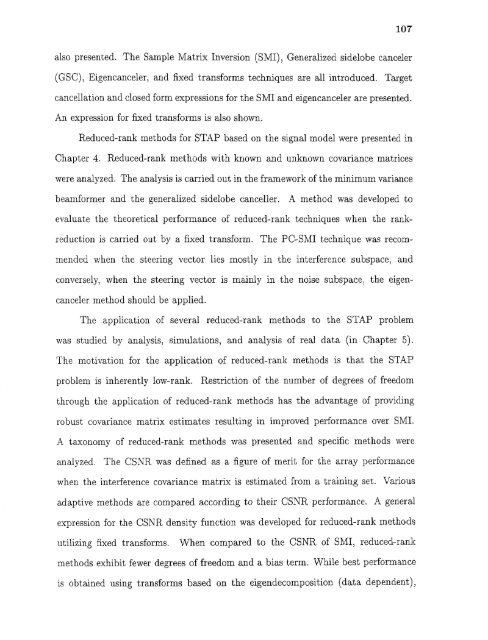Space/time/frequency methods in adaptive radar - New Jersey ...
Space/time/frequency methods in adaptive radar - New Jersey ...
Space/time/frequency methods in adaptive radar - New Jersey ...
You also want an ePaper? Increase the reach of your titles
YUMPU automatically turns print PDFs into web optimized ePapers that Google loves.
107also presented. The Sample Matrix Inversion (SMI), Generalized sidelobe canceler(GSC), Eigencanceler, and fixed transforms techniques are all <strong>in</strong>troduced. Targetcancellation and closed form expressions for the SMI and eigencanceler are presented.An expression for fixed transforms is also shown.Reduced-rank <strong>methods</strong> for STAP based on the signal model were presented <strong>in</strong>Chapter 4. Reduced-rank <strong>methods</strong> with known and unknown covariance matriceswere analyzed. The analysis is carried out <strong>in</strong> the framework of the m<strong>in</strong>imum variancebeamformer and the generalized sidelobe canceller. A method was developed toevaluate the theoretical performance of reduced-rank techniques when the rankreductionis carried out by a fixed transform. The PC-SMI technique was recommendedwhen the steer<strong>in</strong>g vector lies mostly <strong>in</strong> the <strong>in</strong>terference subspace, andconversely, when the steer<strong>in</strong>g vector is ma<strong>in</strong>ly <strong>in</strong> the noise subspace, the eigencancelermethod should be applied.The application of several reduced-rank <strong>methods</strong> to the STAP problemwas studied by analysis, simulations, and analysis of real data (<strong>in</strong> Chapter 5).The motivation for the application of reduced-rank <strong>methods</strong> is that the STAPproblem is <strong>in</strong>herently low-rank. Restriction of the number of degrees of freedomthrough the application of reduced-rank <strong>methods</strong> has the advantage of provid<strong>in</strong>grobust covariance matrix estimates result<strong>in</strong>g <strong>in</strong> improved performance over SMI.A taxonomy of reduced-rank <strong>methods</strong> was presented and specific <strong>methods</strong> wereanalyzed. The CSNR was def<strong>in</strong>ed as a figure of merit for the array performancewhen the <strong>in</strong>terference covariance matrix is estimated from a tra<strong>in</strong><strong>in</strong>g set. Various<strong>adaptive</strong> <strong>methods</strong> are compared accord<strong>in</strong>g to their CSNR performance. A generalexpression for the CSNR density function was developed for reduced-rank <strong>methods</strong>utiliz<strong>in</strong>g fixed transforms. When compared to the CSNR of SMI, reduced-rank<strong>methods</strong> exhibit fewer degrees of freedom and a bias term. While best performanceis obta<strong>in</strong>ed us<strong>in</strong>g transforms based on the eigendecomposition (data dependent),
















